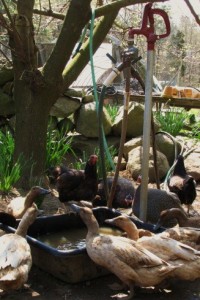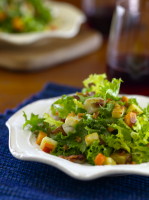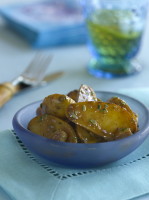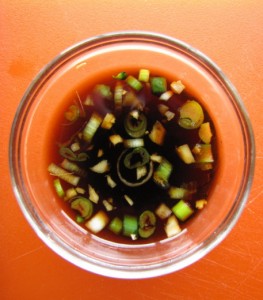 It’s only mid-May, and already the vegetable garden is leading me by the hand, showing me things about myself and my world that I sometimes ignore, don’t appreciate enough—or might not choose to think about all the time. Like the fact that I have pale skin (#30 sun block, my new best friend), am not in great shape (achy back and knees), and HELLO, I can’t do everything myself. Lately, I’ve been feeling really, really grateful for my partner Roy, who, when I suggested the crazy “production” garden idea last fall, embraced the idea enthusiastically. I’m quite sure I’d be a complete nervous wreck by now if he weren’t on the case, what with my book just coming out, deadlines swirling, etc., etc.
It’s only mid-May, and already the vegetable garden is leading me by the hand, showing me things about myself and my world that I sometimes ignore, don’t appreciate enough—or might not choose to think about all the time. Like the fact that I have pale skin (#30 sun block, my new best friend), am not in great shape (achy back and knees), and HELLO, I can’t do everything myself. Lately, I’ve been feeling really, really grateful for my partner Roy, who, when I suggested the crazy “production” garden idea last fall, embraced the idea enthusiastically. I’m quite sure I’d be a complete nervous wreck by now if he weren’t on the case, what with my book just coming out, deadlines swirling, etc., etc.
I bring this up only because I thought if anyone else is contemplating a big garden project like this, you might appreciate the suggestion to do it with a partner. The funny thing is, it’s not so much the (physical) load-sharing I appreciate. (Though there’s plenty of that, like the hour Roy spent fertilizing seedlings last night while I did some writing). It’s the cerebral stuff—the great ideas and the practical solutions that Roy brings to the garden because he thinks differently than I do (and often acts more quickly, too). Watching Roy work out the solution to some garden problem we’re having often turns into an “a ha!” moment for me, stimulating some long-sleepy area of my brain. Better still, the solutions in action are almost always some of the most fun garden moments we have.
Last week we needed to take the row cover fabric off of our baby pea plants and little bok choys, but we were still concerned the crows might get to them. “We need a scarecrow!” Roy kept saying. Sure, that sounded like a good idea to me, but I know if it had been up to me, we’d still not have a scarecrow. It was Roy who rustled through his old clothes to find a pair of jeans, a sweatshirt, a tee-shirt for the face, and a hat, and then stuffed them full of hay. He tied Mr.  Scarecrow up with twine, took him to the garden and tied him to the deer fence, and all Libby (his daughter) and I had to do was come in at the last minute to draw a face on Mr. Scarecrow and take his (and Roy’s) picture! So far Mr. Scarecrow is doing a great job, even fooling several human passers-by.
Scarecrow up with twine, took him to the garden and tied him to the deer fence, and all Libby (his daughter) and I had to do was come in at the last minute to draw a face on Mr. Scarecrow and take his (and Roy’s) picture! So far Mr. Scarecrow is doing a great job, even fooling several human passers-by.
This weekend it became clear that our newly planted beds of lettuce, chard, arugula, and spinach were in bad need of mulching. We’ve had very little rain this spring, we don’t yet have drip hoses in place, and the soil is so dry that it isn’t holding the water from our morning douses very well. We’re also trying to keep our expenses down, so buying mulch for all these beds isn’t a great option. “We need seaweed,” Roy said. At first, I couldn’t quite wrap my head around this. I’ve heard seaweed makes a great addition to compost, and I thought it was something you laid out (in its wet form) on your garden beds over the winter. It hadn’t occurred to me what a great mulch dried seaweed makes.
“Get in the car,” Roy said Saturday morning, dragging me away from the computer. “We’re going to the beach.” He had stuffed a couple of tarps into the back of the car, and off we went. It was one of those big blue-sky days, warm and sunny, breeze gently blowing. We wore shorts and tee-shirts, dug our toes into the sand, and scooped up two tarp-loads of dried seaweed. I looked around at one of the most breathtaking vistas on Martha’s Vineyard – Rugosa roses and beach plums already blooming along the sand dunes that spilled out across the shore—and thought, what in the world could possibly be a more enchanting activity?  Back at the garden, it felt so satisfying to spread the seaweed around the seedlings (like this arugula, right), knowing the soil would now stay moister (and a little less weedy).
Back at the garden, it felt so satisfying to spread the seaweed around the seedlings (like this arugula, right), knowing the soil would now stay moister (and a little less weedy).
There are lots more ways that Roy has made the practical solutions fun for us—like the cold frame he made out of an old sliding door. At first we had it positioned outside the deer fence, but found that awkward. “Let’s move this inside,” Roy said. Now it sits centered along one edge of the garden, surrounded by pansies that Libby and I planted. It doubles as a perch; at the end of a working day, we close it, sit on top it, and look out to admire our beds. And then there’s the bamboo pea trellis (another adventure to collect the bamboo) and the refurbished wooden wagon (from a church).  But again, it’s not the trellis or the wagon—the material things—that matter so much. It’s what the garden offers as a true microcosm for everything in life: Without our friends, without help, without fresh ideas, we—and the garden—can’t thrive. I know the garden has more lessons in store for me this summer, but I’m glad I learned this one early on.
But again, it’s not the trellis or the wagon—the material things—that matter so much. It’s what the garden offers as a true microcosm for everything in life: Without our friends, without help, without fresh ideas, we—and the garden—can’t thrive. I know the garden has more lessons in store for me this summer, but I’m glad I learned this one early on.








































